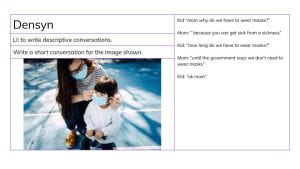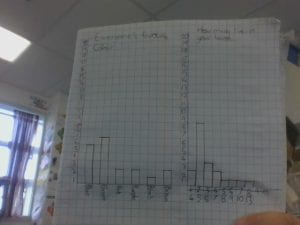I did a task called commanding conversation.
I had to make a conversation using the photo.
I enjoy this activity because I did a commanding conversation.

I did a task called commanding conversation.
I had to make a conversation using the photo.
I enjoy this activity because I did a commanding conversation.

I learned a skit.
First I learned what a skit is. A skit is a performance similar to a play. For a skit it needs a message, problem and a solution, script, character, description, and a setting.
Next we wrote as many messages as we know for our performance. For our message it was, hard work always pays off, we then picked the characters for the performance.
Lastly we wrote the actions and what the characters are gonna say for the performance. I practised with my group saying our lines for the play.
I learned statistics.
First I practised drawing a tally chart, for a tally chart it needs a subject, tallys, and a frequency.
Next I practised drawing a bar graph, I first drew a line that is 20 boxes down. I added the numbers to each box, I drew upwards seeing what colour does everyone like the most.
Last I wrote all the bar graphs with all the subjects that were needed.
I enjoyed this activity because I got to learn tally charts. I did well on my bar graph. I need to improve on my tally chart.



There are four different types of poetry. The four types of poetry are Haiku, Diamante, Limerick, and Cinquain.
A Haiku is in 3 lines, A haiku also tells a moment in time. The syllable count for haiku is 5, 7, 5.
An Cinquain has 5 lines, it is a story or description using a syllable 2, 4, 6, 8, 2.
A Limerick has 5 lines and the topic needs to be something that is normally humorous, and is on the 2nd 5th and 8th beats.
An Diamante has 7 lines, the word count goes in 1, 2, 3, 4, 3, 2, 1, it is just like a reflection, for example a person standing in front of a mirror. which makes it in the shape of a diamond. It uses nouns, adjectives and verbs.
These poems are used for different things.
I learned two sides of an argument.
First I figured out the two sides of the argument. The two sides of the argument for me are that processed food is good for humans and processed food is bad for humans. I read different texts with evidence showing if processed food is good or not good. I summarised in a little group for each text to see everyones opinion.
Next we told all our evidence to eachothers to tell why processed food is not good and good. In a group we agreed that food is good because some outcomes of processed food can be good.
I enjoyed this activity because I got to learn two sides of an argument. I did well on my evidence. I need to improve on understanding the text properly.
I learned ratios and rates.
First I learnt ratios. A ratio is a relationship between 2 numbers by division.
Next I learnt about rates after learning about ratios. A rate is a comparstion.
Last I did a DLO explaining what a ratio and a rate is. And I answered the ratios and the rates.
I enjoyed this activity because I learned about ratios and rates. I did well on rates. I need to improve on my ratios.
I learned volleyball skills. The volleyball skills we learnt was setting, digging, and serving.
First I practised a set. The volleyball needs to be above my head to do a set to my partner. To do a set I use my fingers to push the ball up. I tried doing as many sets as I could with my partner.
Next I practised digging. To do a dig I need to stretch my hands out forward and keep my hands together. I have to hit it with my arm but not my wrist or hands because it hurts my hands.
Then we played a game using both skills. Our team has to hit the ball, everytime our team hits the ball we say a letter, we have to say the whole alphabet until we say that many times for each alphabet.
Lastly, we played a game of volleyball. The serving person needs to hit the ball over the net for the other team to hit it back to the team that serves. Our team was communicating but we still lost.
I enjoyed this activity because I learned volleyball skills. I did well on setting the ball. I need to improve on digging the ball over the net.
Cultural stories have different story types.
The story types there are myth, legend, fairy tale, and fable.
A myth tells people how natural things work.
A legend tells about events or people.
A Fairy tale tells stories involving fantastic creatures or forces.
Last of all a fable tells a lesson for other people to learn.
Cultural stories always have different stories about their culture or other peoples culture.
The structure of a persuasive text is OREO.
The O stands for opinion.
Also the R stands for the reason.
Even the E stands for the explanation.
At last the O stands for opinion again.
Opinions have reason on something they are talking about. The explanation is to explain your opinion. The last opinion is the used to win the conversation
I learned to evaluate a text.
First I read a text that was about a swimming pool in China. After reading the text we started to do our discussion. Then the questioner asked, “Would you swim in this swimming pool”? I told my opinion that I would not swim in this swimming pool.
Then we brainstormed all of our ideas onto the white board. We talked about why it’s dangerous and why it’s not dangerous.
Lastly, I told my real opinion, I would not swim in this swimming pool because I could catch a disease or a virus, causing me to spread it to family members without knowing.
I enjoyed this activity because I got to learn how to evaluate. I did well on evaluating. I need to improve on my reason why I would not swim in a swimming pool that is crowded.